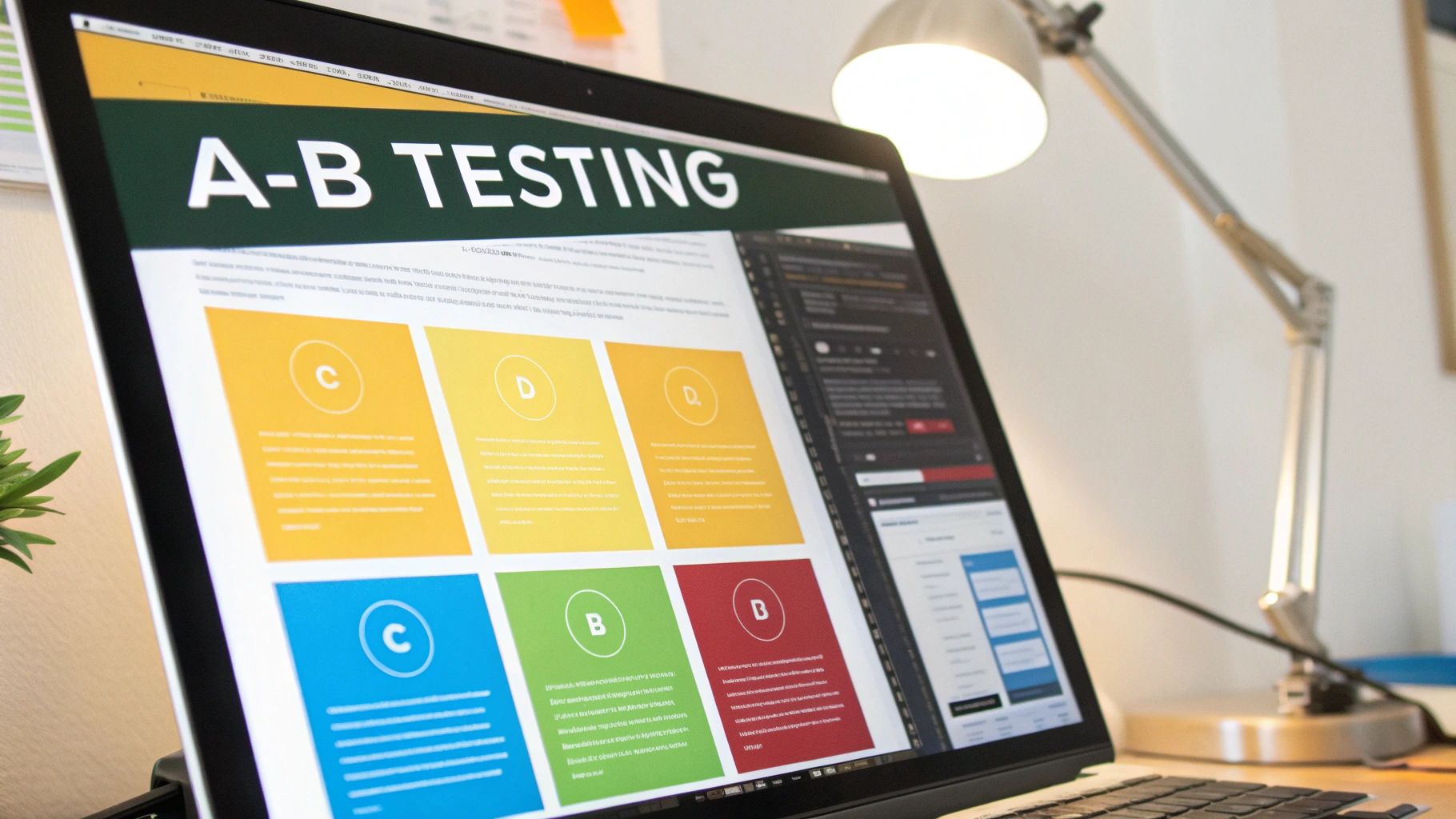The Ultimate Guide to Landing Page Conversion Optimization: From Strategy to Implementation
The Strategic Power of Multiple Landing Pages

Success in landing page optimization comes down to showing the right message to the right people at the right moment. Rather than relying on a single generic page, smart marketers create custom experiences for different audience segments. By speaking directly to specific needs and challenges of each group, they see much better conversion rates. One broad approach rarely works well when trying to connect with diverse audiences.
Segmentation and Targeting: The Key to Higher Conversions
Think about fishing - a net with big holes might catch some fish, but many swim right through. A net with the right-sized holes catches more of exactly what you want. The same goes for landing pages - when each one focuses on a specific audience segment, they convert much better than a single general page. For instance, a software company might have different pages for small businesses, large enterprises, and individual users. This way, the messaging and visuals resonate perfectly with each group.
Scaling Landing Page Creation Without Sacrificing Quality
Making multiple landing pages doesn't have to be overwhelming. With smart planning, you can create more pages efficiently while keeping quality high. Using templates and reusable elements helps streamline the process. Tools like Linkero make it simple to build and manage multiple link-in-bio pages, letting you quickly connect audiences with relevant content while keeping your brand consistent.
Quantity vs. Quality: Striking the Right Balance
Some think more landing pages automatically mean better results. But quality matters more than quantity. Focus on having the right number of well-designed, strategic pages that truly serve your audience's needs. The numbers back this up: businesses with 21-40 landing pages see conversion increases of nearly 300%, while those with 40+ pages see increases up to 500%. For more data, check out these landing page statistics. These findings show why thoughtful planning matters so much for landing page success.
Managing Your Landing Page Ecosystem
As you build more landing pages, good organization becomes essential. You need systems to track performance and make improvements based on data. Use analytics to understand what works and what needs adjustment. Regular monitoring and updates ensure your pages keep driving conversions over time. This ongoing cycle of measuring and improving leads to lasting success.
Mastering Page Speed for Peak Performance

Your website visitors expect pages to load instantly. When a landing page loads slowly, potential customers leave before seeing your offer. Fast page speed directly impacts conversions and creates a smooth user experience that keeps visitors engaged.
The Impact of Speed on Conversions
Research shows that 47% of users expect landing pages to load within 2 seconds. After that, every extra second of load time causes more visitors to abandon your site. Find detailed research on this at Email Vendor Selection. The data clearly shows that optimizing page speed is essential for capturing and keeping visitor attention.
Optimizing Images for Faster Loading
Images often slow down page load times the most, but they're vital for engaging visitors. The key is finding the right balance between quality and speed through smart optimization:
- Compress Images: Use tools like TinyPNG to reduce file sizes while maintaining visual quality
- Choose Optimal Formats: Use WebP for better compression, or optimized JPGs and PNGs
- Size Images Correctly: Display images at their intended dimensions to avoid loading unnecessarily large files
Code Efficiency and Hosting Solutions
Clean code and reliable hosting form the foundation of fast page loads. Your choice of hosting provider and how you structure your code significantly impact speed:
- Optimize Code Files: Remove extra characters from CSS/JavaScript and combine multiple files
- Use a CDN: Deploy content across global servers to reduce load times
- Pick the Right Host: Choose hosting that matches your traffic needs and includes caching
Tools and Techniques for Speed Optimization
Several free tools can help analyze and improve your page speed:
- Google PageSpeed Insights: Get a detailed performance analysis and specific fixes
- GTmetrix: Generate comprehensive reports with actionable recommendations
- Lighthouse: Test performance, accessibility and SEO directly in Chrome
When you make page speed a priority and implement these optimization techniques, you create a better user experience that leads to higher conversion rates. Quick-loading pages combined with strong design and compelling content give your landing pages the best chance of success.
Crafting High-Converting Page Designs

Great landing page design goes beyond aesthetics. The key is purposefully directing visitors toward specific actions - whether signing up for emails, booking demos, or completing purchases. Success requires mastering visual hierarchy, content flow, and understanding what motivates people to act.
Visual Hierarchy: Guiding the Eye
Think of visual hierarchy as creating a roadmap for visitors' eyes. Your goal is to lead them naturally from your headline to supporting elements and ultimately to your call-to-action (CTA). Size, color, contrast and white space work together to direct attention. For instance, larger headlines naturally grab focus before smaller text.
Content Flow: Telling a Story
Like any good story, your landing page needs a clear beginning, middle and end. Start by presenting a problem, introduce your solution, then prompt action. Each section should flow logically into the next while speaking directly to your audience's needs. Clear headings, bullet points and concise paragraphs make the content easy to scan and digest.
Finding the Optimal Content Length
The right page length depends on your product complexity and audience. Research shows that long-form landing pages can increase leads by 220% versus shorter versions, especially with CTAs at the bottom. However, for SaaS products, pages between 250-725 words tend to perform best, with typical conversion rates around 3.8%. Learn more at Optinmonster.
Positioning Critical Elements for Maximum Impact
Where you place key elements like CTAs significantly affects results. While there's no universal solution, A/B testing helps determine what works for your specific audience. Using heatmap tools reveals how visitors interact with your page, highlighting opportunities for improvement. Let this data guide your design choices.
Maintaining Engagement Throughout the Visitor Journey
Keep visitors engaged from arrival through conversion with compelling visuals, interactive elements and clear messaging. Tools like Linkero help create professional bio link pages that connect audiences with relevant content. Regular testing and refinement of landing page elements based on performance data is essential for maintaining strong conversion rates over time.
Implementing Strategic A/B Testing
A/B testing helps you find what works best for converting visitors into customers. Rather than making random changes, you need a clear plan to test different page elements systematically. By following a structured approach, you can make data-driven decisions about your landing pages.
Prioritizing Test Elements for Maximum Impact
Some page elements affect conversions more than others. Focus your testing efforts on high-impact areas like:
- Headlines and main messaging
- Call-to-action buttons and text
- Form fields and signup process
- Key benefits and value propositions
- Page layout and visual hierarchy
Testing these critical elements first will help you see meaningful improvements more quickly.
Ensuring Statistical Significance: Avoiding False Positives
The changes you see in your test results need to be statistically valid. This means having enough data to be confident that differences between page versions are real, not just random fluctuations. Most A/B testing tools require a 95% confidence level before declaring a winner. This helps prevent making changes based on unreliable data that could hurt your conversions.
Implementing Changes and Iterating for Continuous Improvement
After finding a winning page version, implement those changes on your live page. But don't stop there - A/B testing should be ongoing. Only 17% of marketers currently use A/B testing for landing pages, even though it can boost conversions by 12% on average according to recent studies. Keep analyzing performance data, identifying opportunities, and running new tests to steadily improve results.
Frameworks for Test Design, Analysis, and Implementation
Use established frameworks to guide your testing process. The EPIC framework helps structure your approach:
- Evaluate current performance and opportunities
- Prioritize tests with highest potential impact
- Implement changes systematically
- Communicate results and learnings
The scientific method is another helpful framework - form a hypothesis, design an experiment, analyze results, and draw conclusions.
Practical Tools for Tracking Test Performance
Several tools can help manage your testing program effectively:
- Google Optimize and Optimizely for running A/B tests
- Hotjar and Crazy Egg for heatmaps and behavior analysis
- VWO for comprehensive testing and analytics
- Linkero for managing multiple bio link pages and tests
These tools provide the data and insights needed to identify what changes will improve your conversion rates.
How Psychology Affects Landing Page Conversions

Understanding visitor psychology is essential for landing page success. When you grasp what drives people to take action, you can design pages that connect with your audience and guide them naturally toward conversion. The key is building authentic relationships while gently leading visitors toward your goals.
The Impact of Social Validation
People look to others when making decisions. Real customer testimonials, reviews, and social shares build credibility that motivates action. A simple message like "Over 10,000 happy customers" can dramatically influence how visitors perceive your offering. This type of social proof helps reduce uncertainty and gives people confidence to move forward.
Creating Authentic Urgency
Limited-time offers and scarcity can motivate quick decisions by tapping into fear of missing out (FOMO). For example, a "24-hour flash sale" often boosts conversion rates. However, any urgency tactics must be genuine - fake scarcity destroys trust and hurts your brand long-term.
Earning Trust Through Honesty
Trust is fundamental for landing page success. Be upfront about pricing, share real customer experiences, and avoid overstating claims. This straightforward approach builds strong relationships with your audience and naturally increases conversions over time.
Making Meaningful Connections
Connect emotionally by using visuals and language that reflect your audience's values and aspirations. If you sell fitness products, show healthy, active people living their best lives. This emotional resonance makes your message and call-to-action more compelling.
Smart Ways to Use Psychology
Use psychology ethically to guide - not manipulate. Try these proven approaches:
- Focus on Benefits: Show how your offering improves lives rather than just listing features
- Use Clear Action Words: Make calls-to-action direct and obvious about next steps
- Personalize When Possible: Adapt messaging to visitor segments for better relevance
- Remove Friction: Minimize form fields and offer multiple payment options to make converting easy
Optimizing Your Link in Bio With Linkero
Linkero helps you put these psychology principles into practice. Create customized link-in-bio pages that build trust through social proof, run targeted offers, and track results to keep improving. By thoughtfully applying psychology while staying authentic, you'll see better landing page performance. Remember - real connections and trust lead to lasting success.
Building a Continuous Optimization Framework
A successful landing page requires ongoing attention and care. Like maintaining a garden, you need consistent effort to help it grow and produce results. Creating an effective system for measuring, analyzing and refining your pages helps ensure they deliver maximum value over time.
Establishing Robust Tracking Mechanisms
Strong tracking forms the foundation of optimization. This means going beyond basic conversion metrics to understand the complete visitor journey - from traffic sources to on-page behaviors and final outcomes. Tools like Google Analytics provide detailed user data to identify improvement areas. Heat mapping tools like Hotjar show exactly how visitors interact through clicks, scrolls and engagement patterns.
Setting Meaningful Benchmarks and KPIs
With tracking in place, establish clear performance targets and Key Performance Indicators (KPIs). These measurable goals help gauge progress and prioritize improvements. Look beyond overall conversion rate to metrics like bounce rate, time on page, and element-specific click rates. For email collection pages, closely monitor opt-in form performance. Clear KPIs keep optimization focused and measurable.
Creating Feedback Loops for Continuous Improvement
Effective optimization requires consistent feedback cycles. Use your data to identify issues and test solutions. High bounce rates might signal slow loading, unclear messaging, or mismatched traffic. Form hypotheses based on these insights and validate through A/B testing. This cycle of measuring, testing and refining drives ongoing performance gains.
Building and Managing Optimization Teams
Larger organizations benefit from dedicated optimization teams combining analytics, UX design and copywriting expertise. Define clear roles and responsibilities. Regular team communication ensures alignment on goals and strategies. This collaborative approach enables comprehensive optimization across all page elements.
Resource Allocation and Maintaining Momentum
Smart resource planning helps sustain optimization efforts. Budget appropriately for tools, training and staff. Balance quick wins with long-term improvements. While small fixes help, focus on building lasting optimization processes. Celebrate team successes to maintain energy and enthusiasm. Sustained optimization leads to better landing page results over time.
Ready to improve your online presence and boost conversions? Linkero provides a powerful yet simple platform for creating and optimizing your link-in-bio page. Organize your important links, track performance metrics, and deliver a smooth experience for your audience. Start optimizing today!


